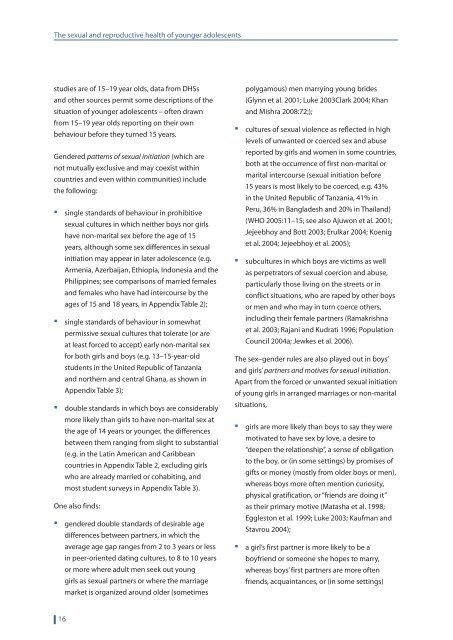The sexual and reproductive health of younger adolescents
The sexual and reproductive health of younger adolescents
The sexual and reproductive health of younger adolescents
Create successful ePaper yourself
Turn your PDF publications into a flip-book with our unique Google optimized e-Paper software.
<strong>The</strong> <strong>sexual</strong> <strong>and</strong> <strong>reproductive</strong> <strong>health</strong> <strong>of</strong> <strong>younger</strong> <strong>adolescents</strong><br />
studies are <strong>of</strong> 15–19 year olds, data from DHSs<br />
<strong>and</strong> other sources permit some descriptions <strong>of</strong> the<br />
situation <strong>of</strong> <strong>younger</strong> <strong>adolescents</strong> – <strong>of</strong>ten drawn<br />
from 15–19 year olds reporting on their own<br />
behaviour before they turned 15 years.<br />
Gendered patterns <strong>of</strong> <strong>sexual</strong> initiation (which are<br />
not mutually exclusive <strong>and</strong> may coexist within<br />
countries <strong>and</strong> even within communities) include<br />
the following:<br />
▪<br />
▪<br />
▪<br />
single st<strong>and</strong>ards <strong>of</strong> behaviour in prohibitive<br />
<strong>sexual</strong> cultures in which neither boys nor girls<br />
have non-marital sex before the age <strong>of</strong> 15<br />
years, although some sex differences in <strong>sexual</strong><br />
initiation may appear in later adolescence (e.g.<br />
Armenia, Azerbaijan, Ethiopia, Indonesia <strong>and</strong> the<br />
Philippines; see comparisons <strong>of</strong> married females<br />
<strong>and</strong> females who have had intercourse by the<br />
ages <strong>of</strong> 15 <strong>and</strong> 18 years, in Appendix Table 2);<br />
single st<strong>and</strong>ards <strong>of</strong> behaviour in somewhat<br />
permissive <strong>sexual</strong> cultures that tolerate (or are<br />
at least forced to accept) early non-marital sex<br />
for both girls <strong>and</strong> boys (e.g. 13–15-year-old<br />
students in the United Republic <strong>of</strong> Tanzania<br />
<strong>and</strong> northern <strong>and</strong> central Ghana, as shown in<br />
Appendix Table 3);<br />
double st<strong>and</strong>ards in which boys are considerably<br />
more likely than girls to have non-marital sex at<br />
the age <strong>of</strong> 14 years or <strong>younger</strong>, the differences<br />
between them ranging from slight to substantial<br />
(e.g. in the Latin American <strong>and</strong> Caribbean<br />
countries in Appendix Table 2, excluding girls<br />
who are already married or cohabiting, <strong>and</strong><br />
most student surveys in Appendix Table 3).<br />
One also finds:<br />
▪<br />
gendered double st<strong>and</strong>ards <strong>of</strong> desirable age<br />
differences between partners, in which the<br />
average age gap ranges from 2 to 3 years or less<br />
in peer-oriented dating cultures, to 8 to 10 years<br />
or more where adult men seek out young<br />
girls as <strong>sexual</strong> partners or where the marriage<br />
market is organized around older (sometimes<br />
▪<br />
▪<br />
polygamous) men marrying young brides<br />
(Glynn et al. 2001; Luke 2003Clark 2004; Khan<br />
<strong>and</strong> Mishra 2008:72;);<br />
cultures <strong>of</strong> <strong>sexual</strong> violence as reflected in high<br />
levels <strong>of</strong> unwanted or coerced sex <strong>and</strong> abuse<br />
reported by girls <strong>and</strong> women in some countries,<br />
both at the occurrence <strong>of</strong> first non-marital or<br />
marital intercourse (<strong>sexual</strong> initiation before<br />
15 years is most likely to be coerced, e.g. 43%<br />
in the United Republic <strong>of</strong> Tanzania, 41% in<br />
Peru, 36% in Bangladesh <strong>and</strong> 20% in Thail<strong>and</strong>)<br />
(WHO 2005:11–15; see also Ajuwon et al. 2001;<br />
Jejeebhoy <strong>and</strong> Bott 2003; Erulkar 2004; Koenig<br />
et al. 2004; Jejeebhoy et al. 2005);<br />
subcultures in which boys are victims as well<br />
as perpetrators <strong>of</strong> <strong>sexual</strong> coercion <strong>and</strong> abuse,<br />
particularly those living on the streets or in<br />
conflict situations, who are raped by other boys<br />
or men <strong>and</strong> who may in turn coerce others,<br />
including their female partners (Ramakrishna<br />
et al. 2003; Rajani <strong>and</strong> Kudrati 1996; Population<br />
Council 2004a; Jewkes et al. 2006).<br />
<strong>The</strong> sex–gender rules are also played out in boys’<br />
<strong>and</strong> girls’ partners <strong>and</strong> motives for <strong>sexual</strong> initiation.<br />
Apart from the forced or unwanted <strong>sexual</strong> initiation<br />
<strong>of</strong> young girls in arranged marriages or non-marital<br />
situations,<br />
▪<br />
▪<br />
girls are more likely than boys to say they were<br />
motivated to have sex by love, a desire to<br />
“deepen the relationship”, a sense <strong>of</strong> obligation<br />
to the boy, or (in some settings) by promises <strong>of</strong><br />
gifts or money (mostly from older boys or men),<br />
whereas boys more <strong>of</strong>ten mention curiosity,<br />
physical gratification, or “friends are doing it”<br />
as their primary motive (Matasha et al. 1998;<br />
Eggleston et al. 1999; Luke 2003; Kaufman <strong>and</strong><br />
Stavrou 2004);<br />
a girl’s first partner is more likely to be a<br />
boyfriend or someone she hopes to marry,<br />
whereas boys’ first partners are more <strong>of</strong>ten<br />
friends, acquaintances, or (in some settings)<br />
16
















